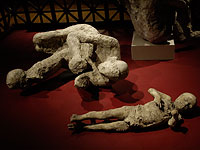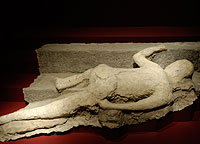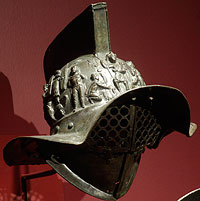In a blinding flash, a city was destroyed—and preserved. In a fleeting moment, lives were lost—and immortalized. Everything changed in the Roman city of Pompeii when Mount Vesuvius erupted on the 24th of August, 79 A.D. And yet, in a perverse twist of fate, everything remained the same for centuries to come.
For 1,700 years, Pompeii and several surrounding towns lay buried under a thick layer of volcanic ash, which preserved them exactly as they were on those fatal days in August. Last fall, some of Pompeii’s most dramatic artifacts arrived in Alabama for a blockbuster exhibition at the Birmingham Museum of Art. The frescoes, jewelry, and other treasures that made the trip from Italy offered more than a glimpse into a past civilization. They threw open a wide window into an ancient world, providing a picture of the past as clear as a 21st-century computer screen.
A Special Kind of Disaster
“This is our YouTube of 2,000 years ago,” says UAB geologist Scott Brande, Ph.D. “It’s like social networking. You have a community of people who died within hours, but their lives were preserved as a snapshot.”

It is a snapshot that still fascinates across the intervening millennia. The Pompeii exhibition attracted more than 95,000 visitors, making it the second-most popular event in museum history. UAB historian Daniel R. Lesnick, Ph.D., who taught a course on Pompeii and ancient Rome that ran in conjunction with the museum exhibit, says it was “one of the most successful classes I’ve had in terms of student involvement.”
What is it about this doomed coastal town? Why are we considerably more interested in what happened that fateful day at Pompeii than, say, in Indonesia in 1815, when the eruption of the Tambora volcano led to a staggering 92,000 deaths?
Because, as we are often told, seeing is believing. Tambora is presented as unemotional history, mere words on paper and numbers we cannot truly comprehend. Pompeii, however, bursts past the intervening centuries with still-brilliant art, gleaming golden necklaces, and heartbreaking “body casts” that captured hundreds of these unfortunate Romans as they met the horror of death.
“People are interested in the lives of other people,” Brande says. “And we, as voyeurs from 2,000 years later, have insight into not only the deaths of these people—which is the macabre side—but also their lives.”
Twice the Destruction
Pompeii and the nearby resort towns of Herculaneum, Oplontis, and Terzigno had thrived for years in the shadow of Mount Vesuvius before the eruption. It has been estimated that the area had a population approaching 20,000 people, who were drawn to the region partly because of its agricultural fertility. Then came the deadly summer of 79.
There actually were two separate eruptions that rained down destruction that August. Brande says they were distinctly different geological events, and they resulted in different types of death. But together they combined to create the conditions that resulted in Pompeii’s pristine preservation.
“The initial eruption lasted about six hours,” says Brande. It sent fine-grained volcanic ash and pumice into the skies, which then “came down over the city, blanketing it like a heavy snowstorm in Buffalo, New York.” Unfortunately for the people of Pompeii, however, volcanic ash is much heavier than crystallized ice. “The weight of the ash collapsed a lot of the roofs in the city itself,” Brande says. Those residents who didn’t immediately evacuate were crushed inside their homes.
This tragedy produced some of the most unforgettable artifacts of Pompeii: the body casts. The fallen ash eventually hardened, and as the bodies beneath decomposed, they left person-shaped holes behind. Archaeologists exploring Pompeii discovered that by injecting plaster into these holes and then removing the surrounding ash, they could create startlingly lifelike, three-dimensional re-creations of Pompeiians as they cowered in terror at the end of their world.

“They were preserved in a sense by the collapse of the roofs,” Brande says. “The body casts are found in these initial deposits. They eventually hardened and became the tombs of the people in their homes.”
Because the temperature of the volcanic ash was not intense, Brande adds, it also preserved the art and artifacts of the city. “The frescoes were not charred, and wood was not incinerated.”
Despite the damage of the 24th, many residents survived. But as the survivors gathered their belongings to escape the next day, Vesuvius was rocked by an even more powerful explosion, sending out a searing, speeding wave of hot gas—known as a pyroclastic density current—that sealed the fate of those still alive and sealed the city for posterity.
“A lot of gas had built up underneath the existing deposits in the volcano,” Brande explains, “and all of this blew with great force. This pyroclastic surge came out of the volcano and actually rode over the landscape like a radar-evading warplane,” asphyxiating those who remained and adding an additional 10 to 15 feet of debris.
Rediscovering Pompeii
The buried city remained quietly undisturbed until the mid-1700s, when its ruins were accidentally discovered. During the ensuing excavations, archaeologists were stunned at the quality of the preservation.
“There is no other site in existence that shows us a world that existed that long ago,” Lesnick says. “From Pompeii and Herculaneum, we get this incredible picture of what people believed and how they went about their daily lives.”
Surprisingly, those lives were similar in many ways to our own. From the political graffiti on its walls to its overflowing sports arenas, many aspects of ancient Pompeii—and by extension, ancient Rome—do not seem that far removed from the 21st century.
For example, the city itself was laid out in a grid system identical to that found in many modern municipalities. “The grid pattern is very intelligible,” Lesnick says. “It makes logistics much simpler. They quite naturally put major buildings for institutions at the center. You had the major temples all there in the main square, along with the law court and the big market.”
Sprinkled throughout the city streets were restaurants and shops—often located in tiny spaces subleased on the ground floor of a wealthy person’s mansion. Elaborate aqueducts brought water down from the nearby mountains, and many of the more prosperous residents actually had running water in their homes.
“We’re always surprised to find out that people who lived so long ago had such extensive knowledge and sophisticated technological devices,” Lesnick says. “But they were incredibly ingenious about comfort, especially for the wealthy.”
But while many of the similarities are striking, Lesnick argues that the great value in studying Pompeii and ancient Rome is in observing the differences between our cultures. “The most obvious difference was social,” he says. “You had large numbers of slaves from Rome’s conquests. Slavery was in a sense the foundation of the economy, but it wasn’t the race-based slavery that existed in the United States—their talents were used. People from the eastern Mediterranean who spoke Greek tended to be educators, for example. They also could very often be financial administrators or foremen for the wealthier Romans, and eventually buy their freedom and even run for political office. So we find a good number of former slaves or their sons holding major political offices in Pompeii.”
Fight, Team, Fight!

As many people know, slaves also took part in Rome’s gladiator battles. But the story of the gladiators has been warped, Lesnick says. Contrary to popular belief, the “competitions were not all about killing Christians,” he explains. “These guys were heroes—and they weren’t all slaves. In fact, some of them were professional athletes.”
Fans would gather in sprawling outdoor amphitheaters to watch gladiators from neighboring towns take on the local favorites in what was “probably a mix of boxing, kickboxing, and bullfighting,” Lesnick says. Some of the top fighters even had their own fan clubs.
But the passions aroused by these bloody contests surpassed the typical football Saturday in the South, Lesnick argues. “It’s more like what we think of with British soccer hooligans. As a consequence, the amphitheaters were always built either on the edge of town or outside the city walls,” so the authorities could contain rioting fans and keep them away from the businesses and houses downtown.
House M.D.
Spectators who indulged in post-match fights of their own may have ended up in the care of a Pompeiian physician wielding one of the bronze scalpels on display at the Birmingham Museum of Art. The Romans had a relatively sophisticated level of medical knowledge, Lesnick says—certainly greater than what was practiced throughout Europe during the Middle Ages and even during the early years of the United States. Several UAB physicians who attended the exhibition noted that the medical instruments on display looked strikingly similar to modern tools of the trade.
“If you take a nurse from UAB Hospital and ask her to look at these instruments, she’d say they’re not much different than the ones today,” says UAB otolaryngologist Dennis Pappas, M.D., a collector of ancient medical artifacts. “Today they are made of steel, where Roman instruments were made of bronze—we have them because bronze does not rust—but everything we use today can pretty much be traced back to 2,000 years ago.”
Sophisticated internal medicine was still centuries away, but the ancient Romans were willing to slice and dice at any ailment they could see, Pappas says—often with successful results.
“They could do any type of an operation that was on the surface. They could not do internal operations or abdominal or chest surgery, but they could do eye operations to remove cataracts, and they could do it well,” he explains. “They could do hemorrhoid surgeries, or any abscess on the surface. And they could burr into the skull to operate on the outer regions of the brain.”
Along with these instruments for specialists, numerous medical bottles and vials were unearthed in the Pompeii excavations, most of them found inside private residences. According to Pappas, that is because Roman medicine was largely practiced in the home, rather than at a doctor’s office or hospital.
“Typically, the Roman was treated by the head man of the family. He was the physician,” Pappas says. “He didn’t know that much. He wouldn’t treat his next-door neighbor, but he knew just enough to do what he could for his own family.”
More Remains Remain
Graffiti-covered walls, gladiator memorabilia, ancient first-aid kits—these intriguing pieces of Pompeii provide insights into a way of life that is long past, though not physically gone, and certainly not forgotten. And there may still be more discoveries to come.
Only a small percentage of the city has been fully excavated, Brande notes. “It’s clear there must be many more hundreds, perhaps thousands, of remains of people” still buried beneath the ash of Pompeii, he says. “We have scientific excavations that could consume the next 100 years. What else is there to be discovered?”